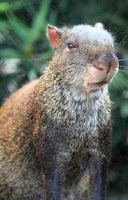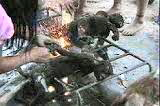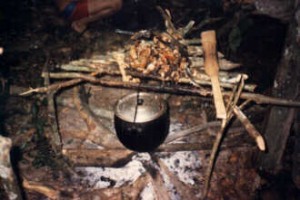Small game is a staple in the diet of both mestizo and indigenous peoples in the Upper Amazon. Frequently hunted mammals include large rodents, such as agouti (Dasyprocta fuliginosa) and capybara (Hydrochaeris hydrochaeris); monkeys, especially howler monkeys (Alouatta seniculus) and spider monkeys (Ateles belzebuth); peccary, including huangana, white-lipped peccary (Tayassu pecari), and sajino, collared peccary (Tayassu tajacu); sachavaca, tapir (Tapirus terrestris); and gray and red brocket deer (Mazama spp.). Most hunting for small game is done with a 16-gauge shotgun.
 |
| Agouti (Dasyprocta fuliginosa) with edible brain and tongue |
Small game is generally gutted but not skinned. Once I was helping my jungle survival instructor, Gerineldo Moises Chavez, field dress an agouti — essentially a large rat. “In North America,” I said, “we generally take off the head.” He looked at me as if I was crazy. “Lots of good things in the head,” he said.
Once gutted, the entire animal is thrown onto a fire. When the hair has been singed, any remaining hair is removed by scraping. Mestizo hunters may then roast the game over a small fire, which can be quite palatable, especially when flavored with albaca, wild basil (Ocimum micranthum), or ajosacha, wild garlic (Mansoa alliacea), which has the additional advantage, hunters believe, of disguising human scent. With some plátano, plantain (Musa paradisiaca), roasted on the fire; some chonta, palm heart; and some huito fruit (Genipa americana) for desert, roast large rodent can be a treat. “You cannot go hungry in the jungle,” Moises told me.
In indigenous villages, on the other hand, the carcass is chopped indiscriminately into pieces, put into a pot of boiling water, and boiled like crazy. This is not gourmet cooking. I tried to introduce the Shapra Indians to the idea of a nicely trimmed monkey roast, but they were disinterested. They preferred just to boil the bejeezus out of their meat.
 |
| Monkey for dinner |
There are, I think, two reasons why small mammals are not skinned. First, there is no use for the skin. Indigenous peoples of the Upper Amazon appear to lack material goods because they can make anything they need very quickly from resources that are ready to hand. I have seen Shapra Indians make a basket out of leaves in just a few minutes, fill it with gathered fruit, carry it back to the village, and simply discard it. It is easier to make the basket than it is to keep it. Second, there is reason to believe that the subcutaneous fat of small game is one of the few sources of fat in the indigenous diet. This may also account for the preference for boiling, which preserves the fat, as opposed to roasting, which does not.
Other small game — birds, tortoises, caimans — is treated pretty much the same way: inedible parts, such as feathers and shells, are removed; everything else is chopped up and boiled. Attractive feathers are kept for making crowns and jewelry; other inedible parts are thrown away.
 |
| Scraping off the hair |
One exception I have seen has been the drying of peccary hides to be carried downriver to market. I remember spending two days in a speedboat filled with the smell of gasoline in 55-gallon drums and a pile of raw peccary hides decomposing in the heat. Vividly.
Once, when I and a few friends lived among the Shapra and Candoshi Indians, we were eating boiled monkey soup. A friend of mine dipped in, pulled out a wrinkled pale piece of meat, and handed it to me. “Please tell me this is not the asshole,” my friend said. I looked at it. I sniffed it. “Yup,” I said. “That’s the asshole.” We discreetly discarded that piece of meat.
 |
| The complete one-pot jungle kitchen, with wooden paddle for stirring the soup |
When hunting is good, extra meat and fish are smoked and salted. Fish that has been salted and dried in the sun makes excellent pack food for long trips; I recall a memorable snack of smoked salted monkey cheeks. Fariña — coarsely ground dried yuca root (Manihot esculenta) — is the jungle survival food of the mestizos. It is light in weight, easy to pack, and, believe me, a little bit goes a long way. It tastes like the worst breakfast cereal you ever had. Fariña can be mixed with water, lemon, and — if you are on la dieta — sugar, to make what is called shibé, which is a significant improvement.
Suri, the grubs of palm beetles (Rhynchophorus palmarum), are such a special treat that I discuss them separately here. Fishing, especially with the fish poison barbasco (Lonchocarpus urucu), will get a blog post of its own.
I would really enjoy hearing other people’s stories of jungle cuisine — with recipes, if possible.

- Previous Post: Terry Riley’s Peyote Ceremony
- Next Post: Some Thoughts on DMT Art
- More Articles Related to: Indigenous Culture, Jungle Survival, The Amazon



Hello. My name is Davey. I stumbled upon your site looking for the name of the song of the plant.. Icharo? Something towards that angle. Anyways, Your site interests me greatly and i was dissappointed to see no comments, so i had to give you props for your work put towards this. Thank you. I’ve always been interested in travels, and i plan to start mine next year around this time, only of america though to start.. I have to wait a year due to probation; i was supposed to be gone now, but fate, life, god, action/reaction all has a way of working out. But i have always been interested in others and not have been able to reach upon any, i suppose i have not tried hard enough, BUT, anways, thank you. How long have you been traveling/documenting?